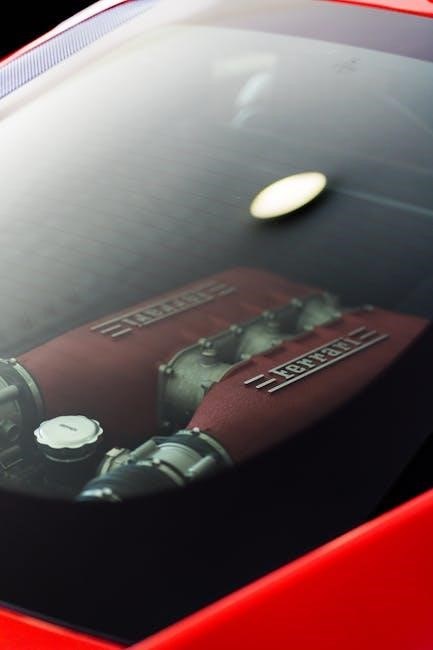When power windows fail, manual intervention is necessary. This guide explains how to safely roll up a power window without electricity, ensuring safety and convenience.

Understanding the Components of a Power Window System
A power window system includes a motor, regulator, and switch. The motor drives the window, while the regulator guides it. The switch controls the motor’s direction.
2.1. The Role of the Window Motor
The window motor is the core component responsible for powering the window’s movement. It converts electrical energy into mechanical force to roll the window up or down. When the motor fails, manual intervention is required. The motor operates by switching polarity to change direction. Testing the motor by applying direct 12V power can diagnose issues. If it works in one direction, it should in the other. This understanding is crucial for troubleshooting and manual operation, ensuring safety and proper function when dealing with a non-responsive power window system. Proper handling prevents further damage during manual roll-up procedures.
2.2. The Function of the Window Regulator
The window regulator is a mechanical assembly that guides the glass pane during movement. It ensures smooth up-and-down motion by tracking the window along a predefined path. The regulator consists of a frame, rollers, and cables or scissors-like mechanisms. When the motor fails, the regulator must be detached to manually lift the window. This process involves removing the glass from the regulator’s grip, often by unscrewing or disengaging clips. Understanding the regulator’s role is essential for safely manual operation, as improper detachment can cause misalignment or damage. Proper handling ensures the window remains secure and functional after manual adjustment, preventing further issues.

Tools and Materials Needed
- Screwdrivers (flathead and Phillips) for door panel removal.
- Pliers for handling cables or broken glass.
- Stick or tool to assist in rolling up the window.
- Tape or loop to secure the window in place.
3.1. Essential Tools for the Task
To manually roll up a power window, you’ll need specific tools to ensure safety and efficiency. Start with a flathead screwdriver or Phillips screwdriver to remove the door panel screws. A pry tool or wire can help detach the glass from the regulator. For securing the window, duct tape or a loop is essential. If the motor is involved, pliers may be needed to handle cables. A stick or similar tool can assist in manually lifting the glass. Ensure all tools are readily available to avoid delays during the process. These tools will help you safely and effectively manage the manual roll-up of your power window.
3.2. Additional Materials That May Be Required
Beyond essential tools, several materials can aid in manually rolling up a power window. Duct tape or a strong adhesive may be needed to secure the window in place temporarily. A stick or similar tool can assist in aligning the glass back onto the regulator track. If the window is off-track, a rubber mallet might help gently tap it back into position. For situations involving motor repair, insulated wire and a 12V power source may be required to test or bypass the motor. Additionally, gloves and safety glasses are recommended to protect yourself during the process. These materials ensure a smoother and safer manual roll-up experience.

Step-by-Step Guide to Manually Rolling Up a Power Window
Manually rolling up a power window involves assessing the situation, removing the door panel, detaching the glass, lifting it, and securing it in place safely.
4.1. Assessing the Situation and Preparing the Vehicle
Begin by evaluating why the power window won’t function. Check if the motor, regulator, or electrical connections are faulty. Ensure the vehicle is in park and the ignition is off for safety. Gather tools like screwdrivers, pliers, and a stick or similar tool to assist. Remove any obstructions near the window to avoid damage. If the window is partially open, attempt to close it slightly to ease manual adjustment. Consider holding the window switch in the up position for 10 seconds to reset the motor. If this fails, prepare to access the door panel and internal mechanisms. Always wear gloves to protect your hands during the process.
4.2. Removing the Door Panel Safely
Removing the door panel is essential to access the internal mechanisms. Start by locating and removing the screws and clips that secure the panel. Use a screwdriver to take out the visible screws, then gently pry the panel away from the door frame using a plastic tool or a flathead screwdriver. Be cautious not to damage the trim or wiring. Disconnect any electrical connectors attached to the panel, such as window switches or speakers, to prevent damage. Once the panel is removed, set it aside carefully to avoid scratching the door or surrounding surfaces. Ensure all tools and materials are within reach to proceed efficiently with the next steps.
4.3. Detaching the Window Glass from the Regulator
To detach the window glass from the regulator, carefully locate the clamp or bracket holding the glass in place. Remove any screws or clips securing the glass to the regulator using a screwdriver. Gently pry the clamp open or slide the glass out of the bracket, taking care not to shatter the glass. If the glass is stubborn, use a rubber mallet or soft tool to tap the clamp loose. Once detached, carefully lift the glass to avoid injury or damage. If necessary, use a loop or stick to secure the glass temporarily while proceeding with the manual roll-up process. Ensure the glass is stable before moving on to the next step.
4.4. Manually Lifting and Aligning the Window
Once detached from the regulator, carefully grasp the window glass with both hands, ensuring a firm grip to avoid dropping it. If the glass is heavy, consider using a loop, stick, or tool to assist in lifting. Slowly guide the window upward, aligning it with the door frame to ensure proper positioning. Use caution to avoid scratching the glass or the door frame. As you lift, check for any obstructions in the window track that may hinder movement. Continue lifting until the window is nearly fully closed, then secure it in place to prevent it from falling. Ensure the window is properly aligned before moving on to the next step to maintain structural integrity and safety.
4.5. Securing the Window in Place
After manually lifting the window, securing it is crucial for safety and to prevent it from falling. Use strong adhesive tape or a temporary fastener to hold the window in its upright position. Ensure the window is aligned properly within the door frame to maintain structural integrity. If available, use a stick or similar tool to wedge the window in place, ensuring it remains stable. Double-check that the window is secure before closing the door or driving the vehicle. This step is essential to prevent accidental movement of the window, which could lead to injury or further damage. Proper securing ensures the window stays in place until professional repairs can be made.

Additional Methods for Manual Window Adjustment
Besides manual lifting, tools like sticks or direct power to the motor can assist. These methods provide alternative solutions for rolling up a power window effectively.
5.1. Using a Stick or Tool to Assist in Rolling Up
Using a stick or tool can be an effective way to assist in manually rolling up a power window. First, ensure the window glass is detached from the regulator to prevent any resistance. Then, carefully insert the stick or tool into the gap between the window and the door frame, gently prying it upward. This method provides additional leverage, making it easier to align the window properly. Once the window is near the top, use the stick to guide it into place and secure it with tape or clamps to hold it steady. This technique is particularly useful if the motor is non-functional and direct power application isn’t feasible. Always handle the glass with care to avoid breakage and ensure the window is securely fastened to prevent accidental movement. By using a stick or tool, you can effectively manage the window’s position until a more permanent repair is possible.
5.2. Applying Direct Power to the Window Motor
Applying direct power to the window motor can be an effective method to manually roll up a power window. Start by removing the door panel to access the motor and regulator assembly. Locate the orange/white and white/black wires connected to the motor. Using a 12V power source, apply power to these wires, ensuring proper polarity. If the motor operates, it will either roll the window up or down, depending on the polarity. Be cautious, as this method bypasses safety features like the anti-pinch function. Once the window is in the desired position, secure it in place to prevent accidental movement. This approach requires basic electrical knowledge and should only be attempted with caution to avoid damage or injury.
Troubleshooting Common Issues During the Process
Common issues include the window not moving, motor failure, or misalignment. Check wiring connections, ensure proper power application, and verify the window’s alignment with the track;
6.1. What to Do If the Window Won’t Move
If the window refuses to move, first ensure the switch is functioning correctly. Hold the switch in the up or down position for 10 seconds to test its operation. Check for loose or damaged wiring connections, especially near the motor or regulator. Verify that the window glass is properly aligned with the track and not obstructed. If the issue persists, attempt to apply direct power to the motor using a 12V source, ensuring correct polarity. If the motor operates manually, the problem may lie in the switch or wiring. If no movement occurs, the motor or regulator might need replacement. Always prioritize safety to avoid further damage or injury.

6.2. Addressing the “Manual Roll-Up Not Working” Problem
If the manual roll-up isn’t functioning, start by inspecting the window’s alignment and ensuring no obstructions exist within the track. Check for any debris or misalignment that could hinder movement. Next, verify the window switch’s functionality by holding it in both the up and down positions for a few seconds to see if it triggers any response. If the issue persists, consider applying direct power to the motor using a 12V source, ensuring correct polarity to avoid damage. If the motor operates with direct power, the problem may lie with the switch or wiring. Additionally, using a stick or tool to assist in manually lifting the window can provide the necessary force to move it. Always prioritize safety by wearing protective gear and avoiding situations that could lead to injury or further damage to the window or door mechanism.

Safety Precautions When Working on Power Windows
When manually rolling up a power window, prioritize safety to avoid injuries or further damage. Always disconnect the battery before starting work to prevent accidental window movement. Wear protective gloves and eyewear to shield against sharp edges or flying debris. Avoid using excessive force, as this could damage the window or surrounding components. Ensure the area is well-lit and free from obstructions to maintain clear visibility. Never leave tools or loose items near the window mechanism, as they could cause unintended activation. If working with electrical components, such as wiring or motors, exercise extreme caution to avoid shocks or short circuits. Lastly, consider having an assistant to help stabilize the window during the process. Safety should always come first to prevent accidents and ensure a successful repair.
Manually rolling up a power window can be a straightforward process if done correctly. By understanding the components and following the steps outlined, you can safely and effectively resolve the issue. Remember to always prioritize safety, disconnecting the battery and wearing protective gear. Using tools like sticks or directly powering the motor can assist, but caution is key. If the window is stubborn, techniques like holding the switch or gently tapping the door may help. While manual methods are effective, addressing the root cause and seeking professional help if needed is essential for long-term reliability. With patience and care, you can restore functionality to your power window and ensure safe, convenient operation.
